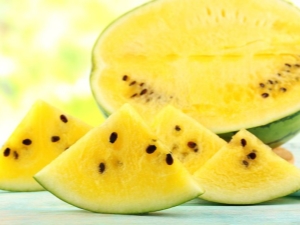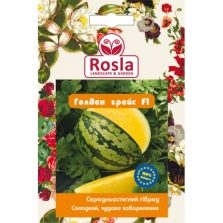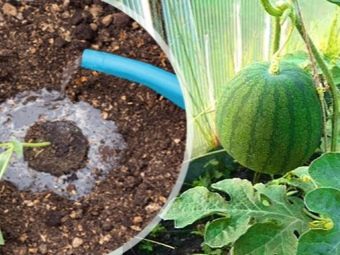Yellow watermelons: the best varieties and cultivation features

How wonderful it is to enjoy watermelon on a hot summer day. This berry is extremely popular among lovers of juicy and sweet products that are grown in garden plots.Among ordinary watermelons, which have red flesh, clearly stood out as a separate variety - yellow watermelon.
View history
Yellow watermelon appeared in the berry world through experiments that were carried out by breeders only a few decades ago. The initial elements that were crossed were wild watermelon and red ordinary.
As you know, wild watermelon can not be taken as food because of the disgusting taste. An interesting fact after crossing was the preservation of only the original color of its pulp.
The resulting berry can have both a round and slightly oval shape, however, in both cases, the color of the pulp remains unchanged - yellow. It also differs from ordinary red and its unique taste. At present, such a watermelon is popularly known as the moon or “baby.” The variety enjoys particular popularity in Spain and Thailand. In these countries, the number of grown yellow watermelons is several times higher than the yield of red.
A yellow watermelon came to Russia recently. His breeding and popularization are actively engaged in the Astrakhan region.
Characteristics and description
Watermelon is considered to be the only berry that can simultaneously be attributed to both fruits and vegetables. Often has a dark skin color, on which there are practically no stripes. Most often grow fruits of small size, but they have unusually juicy flesh of yellow color.
In taste, the variety resembles lemon, mango and pumpkin at the same time. It is interesting that the manifestation of pumpkin properties is determined by the degree of ripeness of the watermelon and belonging to one or another variety.
Yellow watermelon can be safely attributed to the very juicy berries, but it can not be called very sweet. In this berry, there are practically no bones. Among all known watermelons, the most average by weight can be considered a berry of 6 kg, and the minimum - 2 kg. If they are interested in record marks, the largest watermelon had a weight of 159 kg, and it was grown in the USA in 2013.
Varieties
The following types are considered extremely popular:
- "Yellow Dragon";
- Golden Grace;
- "Janosik";
- "Lunar";
- Imbar F1;
- Peach;
- "Yellow Dollar" and others.
"Yellow Dragon" refers to the early varieties, because the fruit ripens in 60 days. The berry is usually slightly oval in shape, has a dark peel, and orange-yellow flesh. Watermelon has a pronounced taste of honey, and its weight ranges from 4 to 7 kg.
“Golden Grace” is considered to be a middle-ripening variety, because it will only be possible to take a sample from its site only after 75 days at least. This hybrid has a bright yellow color inside, and also has a sweet taste that resembles sugar. A distinctive feature of the previous variety is the weight of the berry, which grows much larger (the variety allows you to get copies of up to 8 kg). There is also an excellent advantage - it is maintaining low temperatures, which made it possible to gain popularity both in Russia and abroad.
By early varieties can be attributed, and "Janosik", which has a slightly flattened shape with a light green skin, on which the stripes are barely visible. But this did not affect the taste, but, on the contrary, made the fruit even sweeter. Hybrid has a unique resistance to adverse environmental conditions. Fruits have a weight of 3 kg.
The most popular is the Lunny variety, which has proven itself due to the unique oval shape and striped peel. It also has increased protection against the effects of negative natural influences and has a weight of 3 kg. The watermelon belongs to early grades.
An interesting hybrid that has an ultrafast fruit ripening period is considered to be Primagold F1. He manages to ripen in 40 days, and inside it is impossible to find seeds. As for taste, watermelon has an extraordinary and sweet-sweet taste.Berry has an average weight of 4 kg.
If you want to try a peach, then you can grow a variety of "Peach", which is characterized by large fruit sizes - up to 6 kg. The flesh has a pink-orange color.
For lovers of creating amazing moments there is a "Yellow Dollar". The variety is considered the only among all other varieties of yellow watermelons, the peel of which is edible. The flesh has a distinct honey taste. There is also a unique variety "Kavbuz", which was obtained by Ukrainian breeders. The flesh of such watermelon can not be eaten raw - it is great for cooking various cereals.
“Yellow dragon” is especially popular in Thailand, “Yellow dollars” in the USA, and “Janusik” in Poland.
Agrotechnology
There are several ways to grow yellow watermelon. The most common is the cultivation directly on the garden, but you can first get seedlings from seeds, and only then make the transfer to the site. You should know that this berry belongs to light and heat-loving plants, so you need to choose the right piece of land, where it will be grown. We should not forget about the conduct of irrigation, but also constantly pour the plant is not worth it, because they are subject to critical impact from water hammer, as a result of which they burst.
Particular attention should be paid to the scourge of the plant, which is considered to be unusually delicate and thin, but this does not prevent getting fruits weighing up to 6 kg.
Seed preparation
If the path of growing through seedlings has been chosen, then it is necessary to prepare a mixture of peat, sand, humus and wood ash. In this case, you need to choose the right amount of ingredients: wood ash is taken from the calculation of 200–250 grams per 10 kg of the finished mixture, but everything else is taken in equal proportions.
It is also important to take into account the fact that seedlings are very capricious for transplantingtherefore, it is necessary to produce cultivation in a separate container. Peat cups or disposable tableware have proven themselves well, but you need to make additional holes for water to exit. Attention should also be paid to the volume of the mixture in which the seeds will be planted. The optimal reading is 300 ml. In this case, it is very easy and convenient to get the resulting com.
In order to acquire the seeds, you can visit the usual gardening shop.
It is also recommended to leave them in warm water for a couple of hours before planting, and then transfer them to the potassium permanganate solution for an additional hour, and only then rinse with water. After these procedures, the seeds will be considered ready for planting.
Sowing and grooming seedlings
In order to get a good harvest, it is recommended to start sowing seeds in March or April. The substrate is prepared in specially prepared containers so that it occupies approximately 75% of the space. After that, you need to pour it with water and lay out 2 seeds, then cover with peat mixture. The resulting bed is covered with a film to get a quick result.
After emergence of shoots it is necessary to make moderate watering of seedlings. Water is poured along the edges of the container, and the subsequent loosening of the formed crust is also performed. An important condition is the provision of a 12-hour daylight hours. Experts recommend to pre-acquire the lamp, which will be specifically installed above the seedlings to maintain this indicator.
After the third leaflet appears in the seedlings, it can be fed a little with the help of mineral fertilizers or liquid mullein.
Repotting into the ground
After some time, it will be necessary to proceed to the final stage in the preparation of seedlings, namely, planting on the site. It is necessary to take into account all factors that influence the seedlings: light, heating, soil type.The ideal is sandy or sandy soil, which is located on the south side and has no shade from trees or buildings.
It is important to make a special hardening of their seedlings before planting in the ground. For this you need a couple of days to make it for airing and slightly reduce watering. It is necessary to ensure the integrity of the coma in which the root system of the plant is located.
See the following video for watermelons with colored pulp.


































